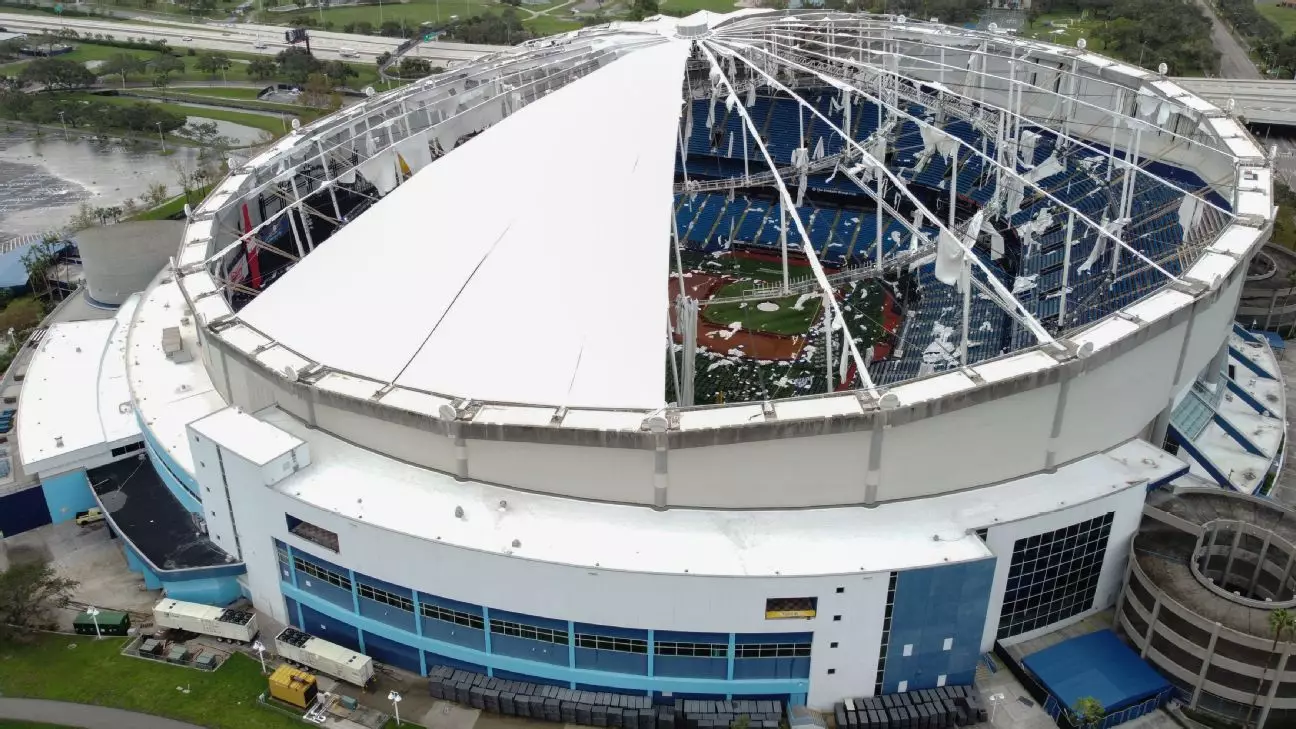In the wake of Hurricane Milton, St. Petersburg faces an imperative task: revitalizing Tropicana Field, once the cherished home of the Tampa Bay Rays. A recent city council decision allocated $22.5 million to initiate repairs, primarily focusing on a new membrane roof that must be in place for further restorations to commence. This commitment stems from a legal obligation to repair the stadium and reflects a broader need for resilience, not just for the Rays but for the community that rallies around them.
Hurricane Milton’s impact was profound, forcing the Rays to temporarily relocate their home games to Steinbrenner Field in Tampa, a venue primarily used for spring training. Here, amidst a whirlwind of uncertainty, the Rays managed a commendable 4-2 record. While playing in a reduced capacity stadium might seem trivial, it speaks volumes about adaptability and the passionate support of their fanbase. It raises the question: how will the community respond now that their playing field is in an unprecedented transitional phase?
Community Sentiments: Ties That Bind
The recent council vote, which passed with a 7-1 margin, reflects more than just a fiscal decision; it embodies the hopes of a city longing for stability in its sports identity. Even though the Rays retracted from a proposed $1.3 billion deal for a new stadium, the council’s actions are rooted in a commitment to the community. Council member Lissett Hanewicz’s remarks emphasize the legal obligations but also hint at the emotional connections tied to Tropicana Field—a meeting place filled with memories, dreams, and local pride.
However, this situation breeds skepticism among residents. The question hangs in the air: Will the Rays pivot back to a more permanent solution in St. Petersburg, or are they merely biding their time while exploring other options? The Rays, established in 1998, have been an integral part of the community fabric, but with major league baseball and community interests at stake, the pressure to keep the team in the region becomes increasingly significant.
The Financial Intricacies: An Investment in the Future
The looming $56 million repair bill for Tropicana Field is daunting. City architect Raul Quintana has outlined a meticulous plan that extends beyond just the roof, which is a priority so that other crucial work can follow. This complex restoration aims to revive the playing surface and enhance electronic systems while ensuring a top-notch experience for fans. Yet, the financial strains resonate beyond the stadium; council member Brandi Gabbard’s voiced frustrations signal a growing impatience among constituents who would rather see funds directed towards broader hurricane recovery efforts instead of what some might view as unnecessary stadium enhancements.
A noteworthy aspect of this renovation is the new roof’s design, engineered to withstand hurricane winds of up to 165 mph. This speaks volumes about the city’s commitment to resilience in the face of climate challenges. With Hurricane Milton reminding everyone of the fragility of life and infrastructure, investing in a durable and sustainable structure for the future is sound. As much as financial implications are at play, the underlying message is this: safety and sustainability should trump temporary inconveniences and expenses.
Looking Ahead: A New Era of Hosting Baseball
While the timeline for completion stretches to around 2026—ample time for plans to evolve—the focus remains on the Rays and their return. Will they leverage this time to forge a deeper connection with their fanbase, or will they drift toward newer opportunities? Major League Baseball emphasizes the importance of keeping the franchise in Tampa Bay, and with the challenges faced and overcome, the Rays have a momentous opportunity to engage their supporters more intimately than ever before.
As the city prepares for this complex initiative, there’s a palpable sense of determination. In an age where sports franchises constantly shift due to market demands and fiscal strategies, the efforts by St. Petersburg to channel resources toward Tropicana Field symbolize a unified acknowledgment of identity and togetherness. Engaging the community, enhancing their facility, and committing to long-term resilience could just create a brighter tomorrow for their beloved baseball team. The narrative here is reshaping—a mixture of lessons learned, an appreciation of history, and a passionate pursuit of a prosperous future.


Leave a Reply